If you are traveling to Hanoi, Vietnam, and love to see some fantastic architecture, you should not miss the Phat Diem Cathedral, located about two hours outside Hanoi, Vietnam. This Cathedral is also featured in Graham Green’s book, The Quiet American.
The Phat Diem Cathedral is about 123 kilometers (76 miles) outside Hanoi, Vietnam. The Cathedral is a unique architectural structure designed and built in the mid-1800s by Father Six, a Vietnamese Catholic Priest. The Cathedral complex has a bell tower, a Cathedral, and smaller chapels and grottoes. British author Graham Greene featured the Phat Diem Cathedral in his book The Quiet American. American bombers dropped eight bombs on the Cathedral in 1972.
Table of Contents
- The Architect – Father Tran Luc or Father Six
- Laying the foundation of the Phat Diem Cathedrals
- Procuring materials for the Phat Diem Cathedral
- Constructing the Phat Diem Cathedral
- Phat Diem Cathedral’s Entrance
- Phat Diem Cathedral’s Bell Tower
- The Phat Diem Cathedral
- The Phat Diem Chapels
- The Phat Diem Cathedral Grottoes
- Graham Greene’s 1951 Visit to Phat Diem Cathedral
- The 1972 American Bombing of Phat Diem Cathedral
- Visiting Phat Diem Cathedral
- Related Content

The Architect – Father Tran Luc or Father Six
The Phat Diem Cathedral architect was Father Tran Luc, or as he was known, Father Six. In French, he was called Pere Six; in Vietnamese, he is known as Cu Sau.
Father Six’s real name was Triem. He was born in 1825 in My Quan village in Nga Son district in Thanh Hoa province in North Vietnam. In 1858 he became a deacon, but before he could become a priest, he was arrested and sent to Lang Son. During this period, many Catholic priests were arrested and imprisoned as the Emperor of Vietnam did not like or trust the Catholics. He became known as Father Six when he was in prison.
If you want to read more about Vietnam’s history, you can read the blog entitled A Short History of Vietnam What You Need to Know by clicking here.
In the 1860s, Father Six was still in prison, but he was allowed to go to his hometown briefly. It was during that time that he took the opportunity to be able to be finally ordained a priest. He was released from prison in 1863 and was eventually put in charge of the Phat Diem parish.
Father Six was a pastor for the Phat Diem parish for 34 years. When he first came to Phat Diem, the area had about 2,000 Catholic parishioners, but there were over 10,000 Catholics in the area when he died. At his funeral in 1899, it is said that over 40,000 people came to honor him and his life. There is little doubt that he was greatly loved and respected.
It took Father Six about 34 years to build the cathedrals. It took him ten years to prepare all the materials and 24 years to build the building. The French or any foreigners did not give money for building the cathedral, but Father Six raised funds from many poor Vietnamese in the local area.
There is little doubt that if a foreigner had built this Cathedral, it would have looked more like the European-style churches of its time. Instead, it has become one of Asia’s most essential and unique architectural churches, built in the Far-Eastern architectural style. The architecture showed that East and Western design styles could be mixed.
It can be said that Father Six was like all great architects or designers: a man who had the vision to think outside the box and the norms of his day. He clearly understood his parishioners and the world around him and built a church that spoke to and reacted to that world.
Father Six was skilled in architecture but excelled in politics, Chinese literature, and Vietnamese poetry. He composed prayers, catechisms, and educational lessons.
He was ahead of his time for a new type of evangelism called “inculturation. Inculturation is defined as:
“Inculturation is the term that Catholic leaders and theologians have used in recent decades to denote a process of engagement between the Christian Gospel and a particular culture. “
Dennis M. Doyle
Father Six was a forerunner in inculturation. Similar to the Jesuit Priest Matteo Ricci and his work in China and the Jesuit missionary Roberto de DeNobili and the work he did in India
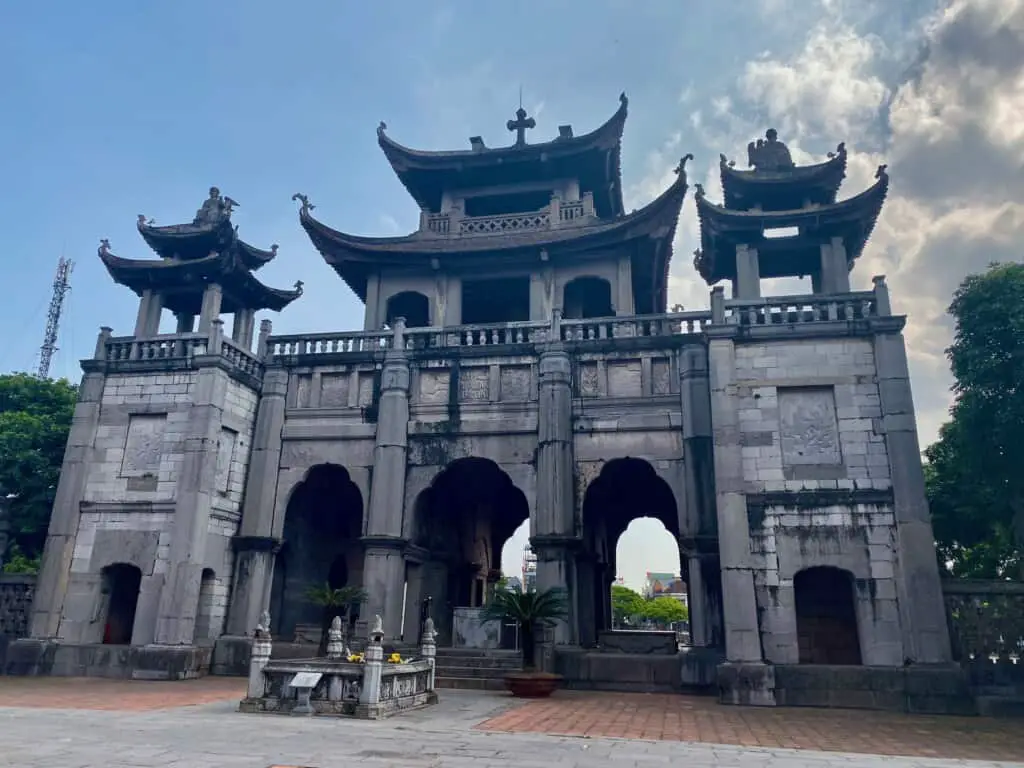
Laying the foundation of the Phat Diem Cathedrals
The land and area that Father Six and his church were located on was a swamp or marshland. To stabilize this ground for the chapels’ building, he had first to prepare the land for building. But they also had to use materials that were readily available to them.
No machinery was used during this time, so everything had to be done by hand. Millions of bamboo stakes were driven about 30 meters into the ground until they could not drive them down any further.
Then earth and gravel were poured on top of that and trampled on by men and water buffaloes. Then bamboo rafts were made and put on top of that. One reason why bamboo was used is not only because of its strength but also because it does well in water. They did all this before any actual foundations were ever laid.
These foundations have withstood the test of time. Not only are they very stable today, but even with 8 bombs dropped on the Cathedral by the American forces in 1972 (see our section below), the cathedral compound has continued to stand strong.

Procuring materials for the Phat Diem Cathedral
One of the most challenging questions Father Six had to resolve was what materials he could use to build the cathedrals. He needed to use materials that were easy to find, cost-effective, and long-lasting.
Almost all the materials had to be brought in from other places as materials are not readily available in this area. Even today, this area is known for basket weaving and farming.
You can watch our video below to see more of the Phat Diem Chapel:
Here are some of the materials and where they had to come from:
- Stone – The stone came from the Thien Duong area, about 30 kilometers or 19 miles away.
- Marble – Marble came from Thanh Hoa Province, about 60 kilometers or 37 miles away.
- Timber – The timber had to come from several places. Some came from Nghe An Province, which is 200 kilometers or 124 miles away, Thanh Hoa Province, which is 60 kilometers or 37 miles away, and Son Tay Province, which is 150 kilometers or 93 miles away.
By today’s standards, these places may not seem that far, but remember, this was in the mid to late 1800s when transporting these materials would have been complicated. There is no wonder it took him over 10 years to gather and find the materials. It would have taken them quite a while to find, locate, and transport these materials to the construction site.
Some of the huge blocks of rock would weigh up to 20 tons. Other large trunks of the trees weighed as much as 7 tons. They brought many of these heavy materials down by bamboo rafts through the waterways and canals and then would unload them at high tide. They would pull them off the rafts and to the building site by men and water buffaloes.

Constructing the Phat Diem Cathedral
Getting the materials was very challenging, as was also the construction. The area this cathedral is located is still quite a small town today compared to other areas in Vietnam such as Hanoi, Ho Chi Minh City, or even Danang.
During this time, all construction had to be done completely by hand as no machinery could be used. Even by today’s standard of construction, these cathedrals would have been difficult, but it was a very ambitious undertaking during that time period.

Here is some information on the construction of the Phat Diem Cathedral:
- Stonework – The stones would have had to have been dragged in place. There was no cement during this time, so the stones were mortared using sand and lime. They would have had to have allowed time for each block to set firmly in place.
- Woodworking – The stone porch entrance of the cathedral was built to help allow for the hoisting of the wood beams. Each of the different partitions in the Cathedral was assigned to a group of carpenters. After just three months of work, some foundation wood beams could be put in place to follow other beams. Some of these wood beams weighed at least 25 tons each.
When you think about the procuring of materials and the construction, it is a testament to Father Six and his ability as an architect, engineer, and project manager to build this cathedral. It is also a testament to the men who worked on the construction site, hauling and lifting those heavy stones, marble, wood, and other materials without any machinery. Only using backbreaking manual labor and some water buffalo to help them.
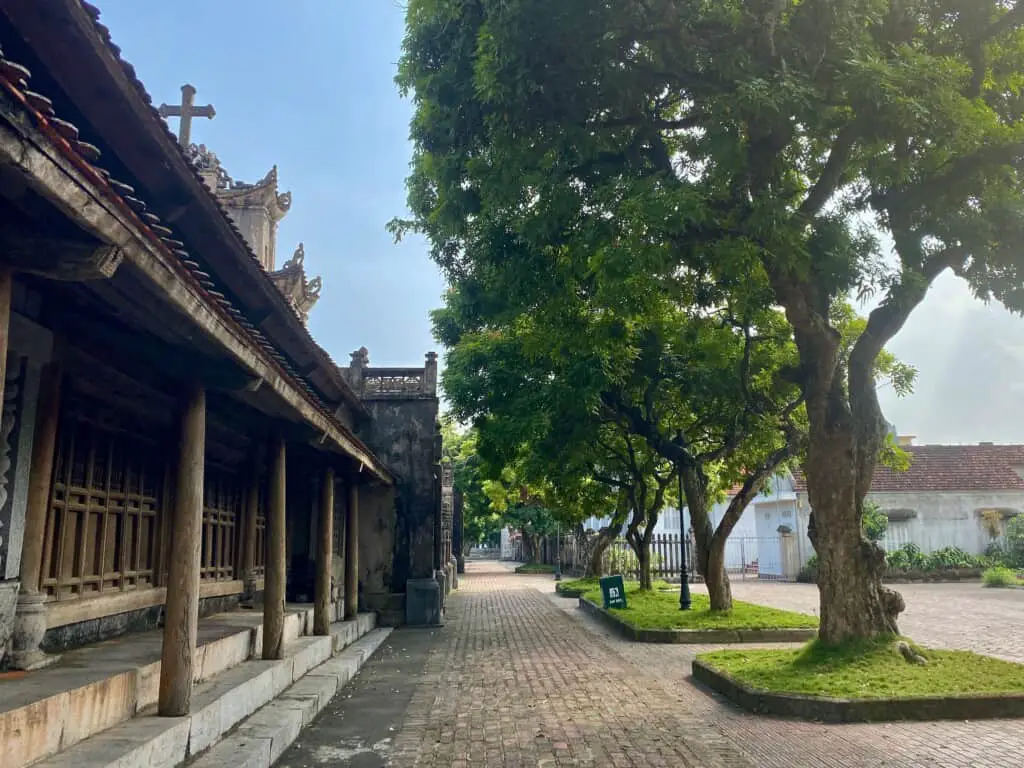
Phat Diem Cathedral’s Entrance
When I first entered the Phat Diem Cathedral’s entrance area, I first noticed a pond with a small island with a statue of Christ outstretched his hands.
It reminded me of the Christus statue, at the Evangelical Lutheran Church in Denmark, except in this statue, Christ’s hands are outstretched higher than the original Christus statue. The Phat Diem Christ statue is called “Christ the King.”
The other thing that struck me was the pond itself. Most Buddhist Temples in Vietnam have a pond in front of them, so besides the Christ statue and the cross that you can see on the horizon, the Cathedral setting from the beginning looks a lot like a Vietnamese Buddhist Temple.
Visitors will also notice that you must step over the threshold to enter any building in the Phat Diem Cathedral complex. This is the same way you must step over the threshold to enter a Buddhist temple. The reason for this is that this is considered a mark of respect.
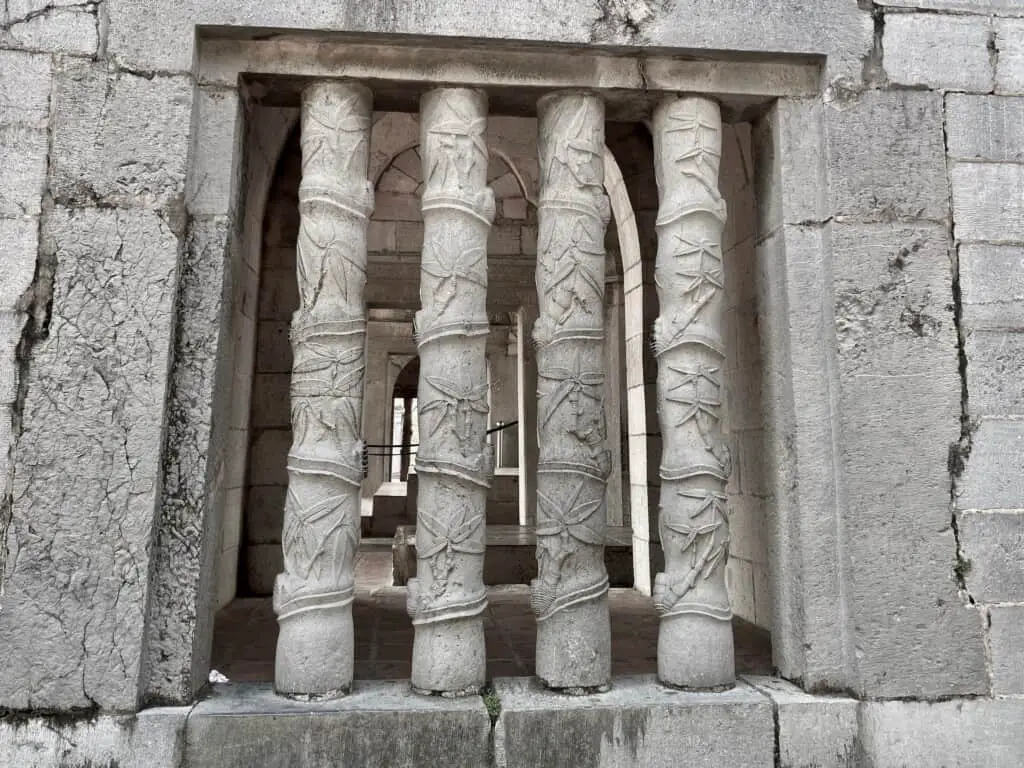
Phat Diem Cathedral’s Bell Tower
The bell tower is the structure near the lake and the first building you see when you enter the cathedral complex. The bell tower was built to represent a typical Vietnamese communal house that is in most Vietnamese villages.
Also located in the back of the bell tower in the courtyard between the bell tower and one of the cathedrals is Father Six’s tomb.
The building is almost square and was built without any doors. Above the central entrance, you can see four large Chinese-style characters that translate to mean “precious seat of the Holy body.”
The smaller characters tell the date of the building, which translates as “Holy Thursday 1899.” On the other side is a Latin inscription that reads “Capella in Coena Domini,” meaning “Chapel for the last supper.”
The bell tower has a very spacious interior. In the center of each section is a large stone slab. This is a communal kind of seat where Vietnamese would sit upright, crossed-legged. The large slab in the middle section was said to have belonged to the Tay Giai Citadel’s royal hall in Thanh Hoa Province.
You can look at the bell tower, and you can almost imagine the thousands of Vietnamese who have sat on these stone slabs talking about everything from Christian teachings to love or just daily life. How many friends were made on those slabs, or how many proposals or love matches were made because of those conversations?
On the bell tower walls are some carved stone reliefs of some saints, along with the bamboo carved stone bars. On the first floor hangs a large drum. This drum is used only on Sundays and festival days to accompany the ringing of the larger bell.
A more giant two-ton bell hangs on the top floor of the bell tower. The bell is struck using a wooden ram, and it is said when the bell rings, it can be heard from at least 10 kilometers away. On a clear day, you can see the seaside to the south and the western mountains from the top of the bell tower.
The bell tower was the last structure in the complex to be completed. Many feel like this is also the finest building in the entire complex.
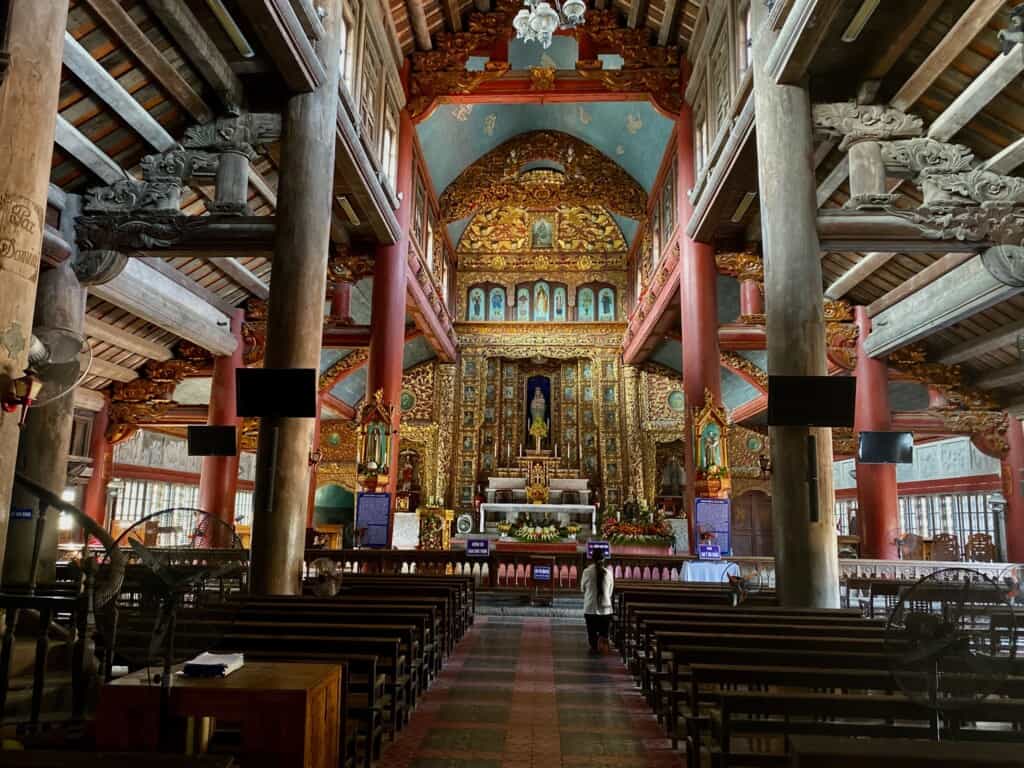
The Phat Diem Cathedral
Right behind the bell tower is the Phat Diem Cathedral. The cathedral has five smaller chapels and some grottoes surrounding it.
On the front of the stone facade of the Cathedral is a hymn in Latin to honor Mary the mother of Jesus, and also a dedication of the Cathedral to Our Lady of the Holy Rosary. This was also signed by Father Six in 1891.
On the very top of the cathedral’s central tower are two angels holding up a cross, and some other angels are blowing trumpets along with four Chinese-style characters that say “foreboding of judgment day.”
Here are some facts about the outside and structure of the Cathedral.
- The towers are made of bricks.
- The five porches are made of stone.
- The central porch is a stone carved with rose bushes spreading its twigs among 17 angels.
- Above the stone porches are 15 stone reliefs representing different parts of Mary and Joseph’s life, also known as the rosary’s 15 mysteries.
- 5 entrances are 9 meters deep (29 feet) and built of stone, leading to some carved doors.
- The roof rests on 52 wooden pillars, 16 11 meters high and 2.60 in circumference. These pillars weigh about 7 tons each.
- You can see two windows made of stone and a carved lion on the side of the outside wall.
When you enter the Cathedral, everyone should be impressed with not only the magnitude of the interior but how quiet and reverent it feels.
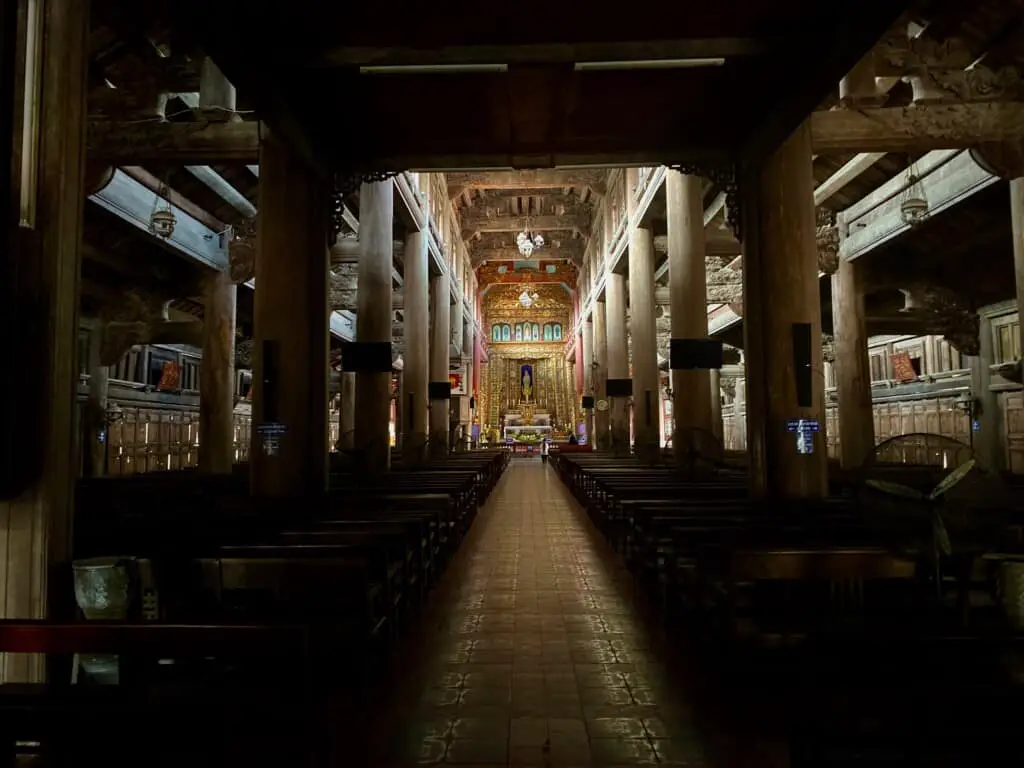
Here is some information about the inside of the Cathedral:
- Above each angel holding a holy basin are sentences in Latin, encouraging Christians with the right attitude they need to have when they come to pray.
- There are some magnificent hand-carved gold lacquer pillars. If you are interested in Vietnamese lacquer, you are read this blog on How to Manufacture Vietnamese Lacquer? by clicking here.
- A very prominent statue is “Our Lady with Infant Jesus.”
- Surrounding the statue are pictures of various Saints.
- On the glass windows are pictures of six martyrs; of these six martyrs, five are Vietnamese, and one is European.
- The top picture is “Our Lady giving the Rosary to St Dominic.”
- A single slab of white stone cut the old altar in the rear. This altar is beautifully chiseled.
- The front altar is new and made of a single slab of stone. This altar was consecrated on 6th October 1991 during the 100th anniversary of the Cathedral.
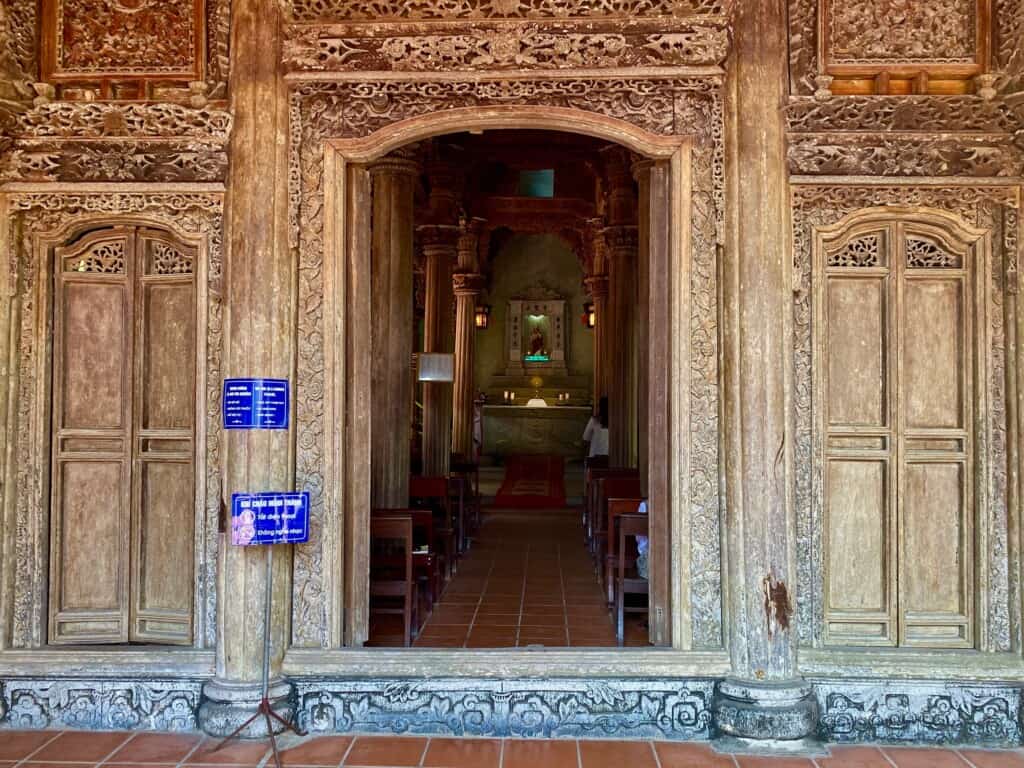
The Phat Diem Chapels
Father Six built 4 smaller chapels surrounding the Cathedral. A fifth chapel was the Stone chapel, built just a bit further away. Some refer to these smaller chapels as the “Ladies in waiting.” Each one of these chapel structures is similar but also, at the same time, unique.
Here is some information about these five chapels.
Saint Joseph Chapel
The front chapel is on the west side and was built entirely of wood. On both walls of the choir are some stone reliefs depicting various episodes of Saint Joseph’s life. A choir inside a church is defined as between the high altar and the nave, used by the choir and clergy.
Saint Peters Chapel
Directly behind the Saint Joseph’s is located Saint Peters Chapel, built entirely out of jack wood. Jackwood is wood from the Jackfruit tree. Father Six dedicated this chapel to the patron Saint Peter.
The windows decorated with stone bars are reliefs portray the twelve Apostles whose names are written in the ancient Vietnamese script. The altar is a single block of stone weighing twenty tons.
The Immaculate Heart or The Stone Chapel
Perhaps the most famous of all the smaller chapels in the stone chapel. This chapel was built in 1883 and was the first to be built.
This chapel was made of stone, including all the floors, pillars, beams, walls, towers, and the altar. The outside facade is carved with stories, including the story of Sword Lake in Hanoi.
You can also see a Phoenix and a lion, smiling human faces. The central tower’s niche has engraved a prayer to the “Immaculate Heart of Mary” in four languages.
Even though this is all made from stone, the interior still looks light due to the high gloss marble decorations, beautiful windows, and sculptures.
The Sacred Heart Chapel
On the east side of the Cathedral is the Sacred Heart Chapel. This chapel has a three-tower facade and beautifully carved doors.
It was said that a French Official asked Father Six to bring these doors to Paris for an exhibition, but Father Six refused as he said the doors had already been given to God.
Saint Roch Chapel
This chapel was built in 1895 and was originally dedicated to Saint John the Baptist. The chapel was renamed after Saint Roch for gratitude for the area to be delivered from the cholera epidemic in 1923.
Except for the altar made of stone, the rest of the chapel is made of Jackwood.
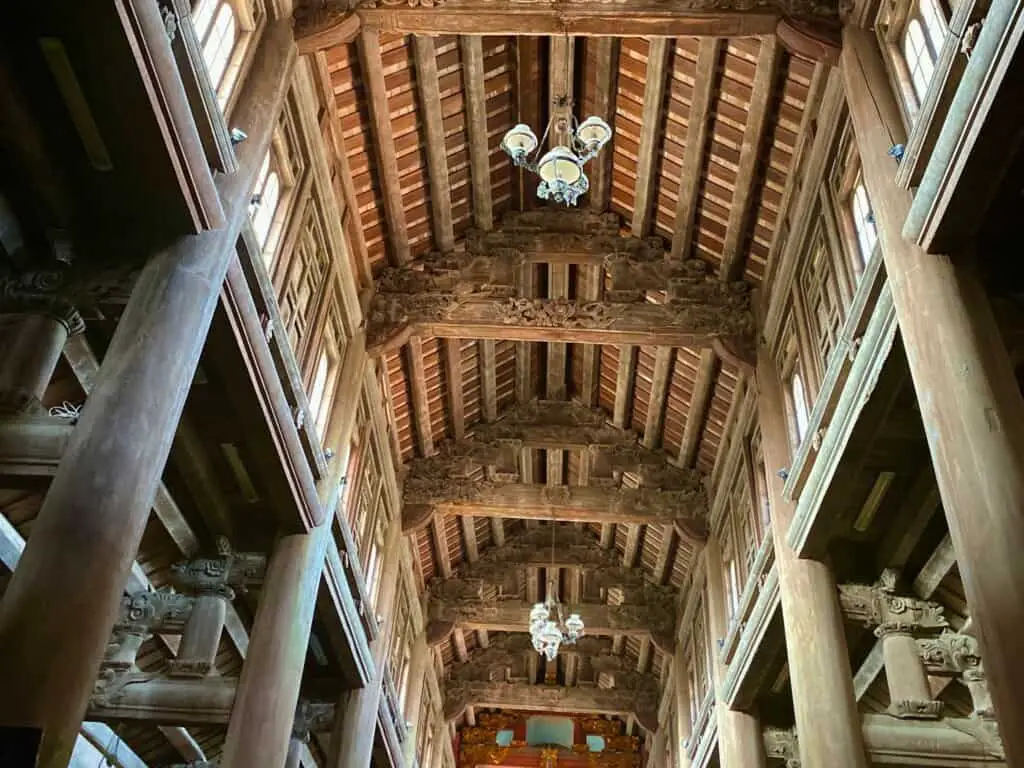
The Phat Diem Cathedral Grottoes
All around the Chapels and the Catherdral area is also some grottoes. Here is some information on grottoes:
The Calvary Grotto
The Calvary grotto is in front of the Stone Chapel. The grotto has a statue of Christ on the cross at Calvary, and under the statues, you can see a cave that looks to represent Christ’s tomb.
The Bethlehem Grotto
The Bethlehem Grotto is east of the Calvary Grotto. This was originally named the Sepulchre Grotto, and it was built by Father Six in 1875 to help test the soil’s stability before starting construction.
The Lourdes Grotto
This is east of the Bethlehem Grotto. As you visit the Lourdes Grotto, you can stop to get a view of the Bishop’s house, where the right wing of the house was built by Father Six over 100 years ago.
This grotto has some beautiful trees, and under some of the trees are the gravesites of two Parish Priests of Phat Diem, plus a layman who was martyred in the 19th Century.
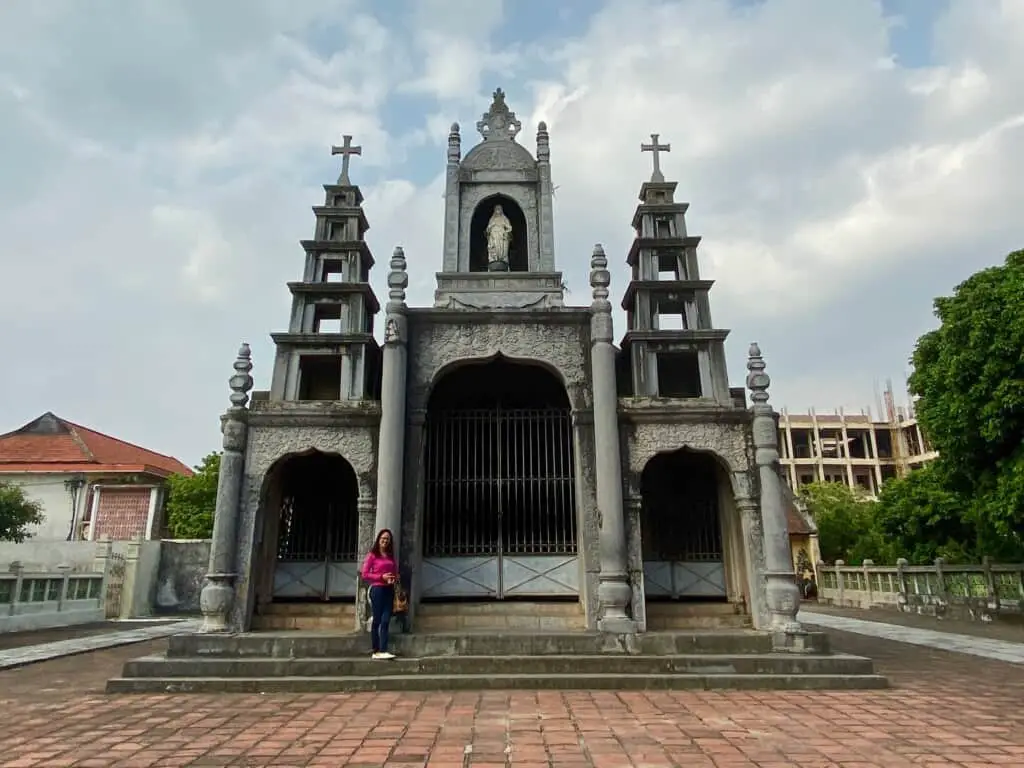
Graham Greene’s 1951 Visit to Phat Diem Cathedral
The famous British author of The Quiet American, Graham Greene, was intrigued by the Phat Diem Cathedral. He came to the Phat Diem Cathedral in 1951 with his friend Trevor Wilson, who was based at the British Embassy in Hanoi. Graham Greene was a practicing Roman Catholic.
In 1951, the French and Viet Minh were fighting, but a third group controlled the area near Phat Diem Cathedral under a Catholic Prince Bishop, Le Huu Tu, and another adjoining Diocese of Bui Chu. Father Tu’s group had its army of about 3,000 men and had about 500,000 Catholics under their control, along with about half a million Buddhists.
Bishop Tu was extremely nationalistic. He did not want to allow the French the rights in his diocese, and the Viet Minh were not friendly to the Catholic population.
Phat Diem Cathedral became involved in the French and Viet Minh war. In 1953 French artillery shells hit the East wing of the Cathedral, collapsing part of the roof.
In speaking about Greene and Wilson’s visit to Phat Diem, Kevin Ruane said:
“The Catholic Greene was captivated by Phat Diem, as was his friend and co-religionist Wilson. Greene also admired Tu’s independence: “my number-one enemy is the French,” Tu told him,“after which come the Communists.” On this first occasion Greene spent just thirty-six hours in this “medieval Episcopal principality” before returning to Hanoi on 1 February. “
Kevin Ruane
Grahame must have been very impressed with the Phat Diem Cathedral in his book The Quiet American. The Phat Diem Cathedral is one of the major places or settings for the book The Quiet American.
When you visit Phat Diem and see the architecture, you can see why it captivated Graham Greene so much that he would put it in his novel The Quiet American.

The 1972 American Bombing of Phat Diem Cathedral
On August 15, 1972, American bombers dropped eight bombs on the Phat Diem Cathedral. They meant to hit all the buildings, but many of them were missed by pure luck. If the bombs had all hit their targets, the entire Catherdal complex would have probably been destroyed.
The bombs hit from the bishop’s house to the pond area. One bomb exploded in an open space on the west side of the Cathedral. It flattened the Saint Peter’s Chapel and caused Saint Joseph Chapel to tilt while sending 36 stone slabs to the ground.
This bomb also almost blew away all the tiles off the Cathedral roof along with most of the wooden doors. Fifty-two out of fifty-six doors were damaged, and the stone reliefs on the station of the cross.
Inside the Cathedral, there was also damage to the altar, as all the gold and lacquer work was covered in dust. The Cathedral tilted 15 to 20 degrees; it was only due to the facade’s strong stonework that kept the Cathedral from not completely collapsing.
During this time, the war was in full swing, and America dropped a record number of bombs on North Vietnam. In December of 1972, America had the Christmas bombing campaign, where 20,000 tons of bombs were dropped on North Vietnam.
The Phat Diem diocese needed to decide if they would wait until the war’s end when the bombing stopped to repair the cathedral or if they would repair it now. They were worried that the damage to the Catherdral would be irreplaceable if they waited too long, especially for the gold lacquer altar in the Cathedral.
The decision was made that despite the war and the possibility there could be additional bombs on the Catherdal, they needed to start to repair the Catherdal complex as soon as possible. The repair work started on the Phat Diem Cathedral in October 1972.
The bomb craters were filled, wood was sawed to repair the wooden doors, and tiles were brought in to repair the roof. About 200 people came to help repair the cathedral, most of them unpaid.
Some carpenters worked for months unpaid and just received some donated rice from local people so they could eat. It took over two years to completely repair the damage done by these eight bombs to the Phat Diem cathedral complex.
The Phat Diem Cathedral is worth visiting. Not only is it a wonderful architectural treasure, but it also has a fascinating history of how the Cathedral complex was constructed. You can see why a renowned author like Graham Greene would have been so intrigued by the Phat Diem Cathedral complex when you visited there.
Visiting Phat Diem Cathedral
You can visit the Phat Diem Cathedral without any advanced reservation. The Cathedral is still an operating church and has Sunday masses; the gates are open for people to visit and worship. There is no admission fee, but you can donate to the church to maintain its buildings. You can get a taxi or private car from Hanoi to bring you there.
You can check out these tour operators on Tripadvisors by clicking here. You can also ask your hotel to help you book a tour or a car.
What hotels are near Phat Diem Cathedral?
The Phat Diem Cathedral is in a tiny town, and there is not very much in the area regarding food or other things to see. Unless you have a reason to stay in the area as you want to visit the Cathedral over a few days, we recommend you stay in Hanoi and take a day trip to the Phat Diem Cathedral. Visiting the Cathedral in a day or half a day is easy.
At A Bus On A Dusty Road, we talk about travel, life, and ex-pat living. We are all about “Living Life As A Global Citizen.” We explore social, cultural, and economic issues and travel.
We would love to have you be part of our community. Sign up for our newsletter to keep up-to-date by clicking here. If you have any questions, you can contact me, Anita, by clicking here.
Listen to our Podcast called Dusty Roads. You can find it on all major podcast platforms. Try out listening to one of our podcasts by clicking here.
Subscribe to our A Bus On A Dusty Road YouTube Channel filled with great videos and information by clicking here.
Related Content
What U. S Companies Profited During The Vietnam War?
During the Vietnam War many U.S. companies profited from the Vietnam war. Some of these companies were heading toward bankruptcy, but their involvement in the Vietnam war helped make them profitable. For many others, they earned millions of dollars each year in profits from the war that helped ensure they continued to be successful or even thriving companies.
By clicking here, you can discover What U. S Companies Profited During The Vietnam War?
Could America Have Won The Vietnam War?
America could not have won the Vietnam war as it never won the hearts and minds of the Vietnamese people. The Americans even had difficulty controlling the Vietnamese people in Southern Vietnam, as many were disillusioned with the Southern Vietnamese government. Ho Chi Minh, the leader of North Vietnam, fully understood that another foreign power would not control the Vietnamese heart and soul.
By clicking here, you can discover Could America Have Won The Vietnam War?
What Was The Main Reason For US Involvement In Vietnam?
The main reason for the involvement of the United States in the Vietnam War was the belief in the Domino theory; the Domino theory was a principle used to describe the effects on the world if Vietnam fell to communism. The idea was that if Vietnam became communist, the rest of Asia, New Zealand, and Australia would eventually become communist. At the time, American leaders felt they were fighting for the survival of democracy throughout the world.
By clicking here, you can learn more by reading What Was The Main Reason For U.S. Involvement In Vietnam?


